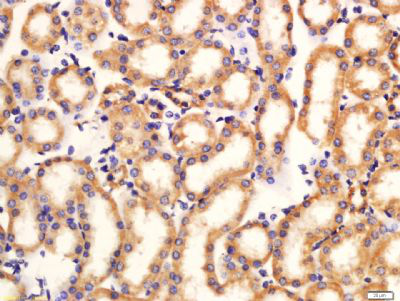产品货号 : mlR5408
英文名称 : Phospho-LRP6 (Thr1479)
中文名称 : 磷酸化低密度脂蛋白受体相关蛋白6抗体
别 名 : LRP6 (Phospho-Thr1479); LRP6 (Phospho-T1479); p-LRP6 (Thr1479); p-LRP6 (T1479); ADCAD2; C030016K15Rik; Cd; FLJ90062; FLJ90421; Low density lipoprotein receptor related protein 6; LRP6_HUMAN; Low-density lipoprotein receptor-related protein 6; low-density lipoprotein receptor-related protein 6 precursor; LRP-6.
产品类型 : 磷酸化抗体
研究领域 : 肿瘤 心血管 免疫学 神经生物学 信号转导 合成与降解
抗体来源 : Rabbit
克隆类型 : Polyclonal
交叉反应 : Human, Mouse, Dog, Pig, Cow, Horse, Rabbit, Guinea Pig,
产品应用 : WB=1:500-2000 ELISA=1:500-1000 IHC-P=1:400-800 IHC-F=1:400-800 Flow-Cyt=0.2ug/test IF=1:100-500 (石蜡切片需做抗原修复)
not yet tested in other applications.
optimal dilutions/concentrations should be determined by the end user.
分 子 量 : 175kDa
细胞定位 : 细胞浆 细胞膜
性 状 : Lyophilized or Liquid
浓 度 : 1mg/ml
免 疫 原 : KLH conjugated Synthesised phosphopeptide derived from human LRP6 around the phosphorylation site of Thr1479:KG(p-T)YF <Cytoplasmic>
亚 型 : IgG
纯化方法 : affinity purified by Protein A
储 存 液 : 0.01M TBS(pH7.4) with 1% BSA, 0.03% Proclin300 and 50% Glycerol.
保存条件 : Store at -20 °C for one year. Avoid repeated freeze/thaw cycles. The lyophilized antibody is stable at room temperature for at least one month and for greater than a year when kept at -20°C. When reconstituted in sterile pH 7.4 0.01M PBS or diluent of antibody the antibody is stable for at least two weeks at 2-4 °C.
PubMed : PubMed
产品介绍background:
This gene encodes a member of the low density lipoprotein (LDL) receptor gene family. LDL receptors are transmembrane cell surface proteins involved in receptor-mediated endocytosis of lipoprotein and protein ligands. The protein encoded by this gene functions as a receptor or, with Frizzled, a co-receptor for Wnt and thereby transmits the canonical Wnt/beta-catenin signaling cascade. Through its interaction with the Wnt/beta-catenin signaling cascade this gene plays a role in the regulation of cell differentiation, proliferation, and migration and the development of many cancer types. This protein undergoes gamma-secretase dependent RIP- (regulated intramembrane proteolysis) processing but the precise locations of the cleavage sites have not been determined.[provided by RefSeq, Dec 2009].
Function:
Component of the Wnt-Fzd-LRP5-LRP6 complex that triggers beta-catenin signaling through inducing aggregation of receptor-ligand complexes into ribosome-sized signalsomes. Cell-surface coreceptor of Wnt/beta-catenin signaling, which plays a pivotal role in bone formation. The Wnt-induced Fzd/LRP6 coreceptor complex recruits DVL1 polymers to the plasma membrane which, in turn, recruits the AXIN1/GSK3B-complex to the cell surface promoting the formation of signalsomes and inhibiting AXIN1/GSK3-mediated phosphorylation and destruction of beta-catenin. Required for posterior patterning of the epiblast during gastrulation.
Subunit:
Homodimer; disulfide-linked. Forms phosphorylated oligomer aggregates on Wnt-signaling. Forms a WNT-signaling complex formed of a WNT protein, a FZD protein and LRP5 or LRP6. Interacts (via the extracellular domain) with WNT1; the interaction is enhanced by prior formation of the Wnt/Fzd complex. Interacts (via the beta-propeller regions 3 and 4) with WNT3A. Interacts (via the beta-propeller regions 1 and 2) with WNT9B. Interacts with FZD5; the interaction forms a coreceptor complex for Wnt signaling and is inhibited by DKK1 and C1orf187. Interacts (via beta propeller regions 3 and 4) with DKK1; the interaction inhibits FZD5/LRP6 complex formation. Interacts with DKK2. Interacts with C1orf187/DRAXIN; the interaction inhibits Wnt signaling. Interacts (via the phosphorylated PPPSP motifs) with AXIN1; the interaction recruits the AXIN1/GSK3B complex to cell surface LRP6 signalsomes. Interacts with GRB10; the interaction prevents AXIN1 binding, thus negatively regulating the Wnt signaling pathway. Interacts (via the extracellular domain) with RSPO1; the interaction activates Wnt/beta-catenin signaling. Interacts (via the extracellular domain) with RSPO3 (via the cysteine rich domain); the interaction activates Wnt/beta-catenin signaling. Interacts (via the beta-propeller regions 1 and 2) with SOST; the interaction competes with DKK1 for binding for inhibiting beta-catenin signaling. Interacts with MESD; the interaction prevents the formation of LRP6 aggregates and targets LRP6 to the plasma membrane. Interacts (via the cytoplasmic domain) with CSNKIE; the interaction phosphorylates LRP6, binds AXIN1 and inhibits AXIN1/GSK3B-mediated phosphorylation of beta-catenin. Interacts with MACF1.
Subcellular Location:
Membrane; Single-pass type I membrane protein. Endoplasmic reticulum. Note=On Wnt signaling, undergoes a cycle of caveolin- or clathrin-mediated endocytosis and plasma membrane location. Released from the endoplasmic reticulum on palmitoylation. Mono-ubiquitination retains it in the endoplasmic reticulum in the absence of palmitoylation. On Wnt signaling, phosphorylated, aggregates and colocalizes with AXIN1 and GSK3B at the plasma membrane in LRP6-signalsomes. Chaperoned to the plasma membrane by MESD.
Tissue Specificity:
Widely co-expressed with LRP5 during embryogenesis and in adult tissues.
Post-translational modifications:
Dual phosphorylation of cytoplasmic PPPSP motifs sequentially by GSK3 and CK1 is required for AXIN1-binding, and subsequent stabilization and activation of beta-catenin via preventing GSK3-mediated phosphorylation of beta-catenin. Phosphorylated, in vitro, by GRK5/6 within and outside the PPPSP motifs. Phosphorylation at Ser-1490 by CDK14 during G2/M phase leads to regulation of the Wnt signaling pathway during the cell cycle. Phosphorylation by GSK3B is induced by RPSO1 binding and inhibited by DKK1. Phosphorylated, in vitro, by casein kinase I on Thr-1479.
Undergoes gamma-secretase-dependent regulated intramembrane proteolysis (RIP). The extracellular domain is first released by shedding, and then, through the action of gamma-secretase, the intracellular domain (ICD) is released into the cytoplasm where it is free to bind to GSK3B and to activate canonical Wnt signaling.
Palmitoylation on the two sites near the transmembrane domain leads to release of LRP6 from the endoplasmic reticulum.
Mono-ubiquitinated which retains LRP6 in the endoplasmic reticulum.
N-glycosylation is required for cell surface location.
DISEASE:
Defects in LRP6 are the cause of autosomal dominant coronary artery disease type 2 (ADCAD2) [MIM:610947].
Similarity:
Belongs to the LDLR family.
Contains 4 EGF-like domains.
Contains 3 LDL-receptor class A domains.
Contains 20 LDL-receptor class B repeats.
SWISS:
O75581
Gene ID:
4040
Important Note:
This product as supplied is intended for research use only, not for use in human, therapeutic or diagnostic applications.
产品图片












